Abstract
Deep temperate lakes are increasingly reported to suffer consequences of climate warming, affecting thermal stratification and plankton seasonality. Long-term studies offer a unique opportunity for detecting changes in the zooplankton taxa composition related to climate change. Sampling zooplankton organisms alongside abiotic variables, such as water column temperature, enables the linking of changes in plankton communities with variations in the stratification regime. This provides evidence of direct and indirect warming effects. Our study in Lake Maggiore investigated variations in the population density and persistence of Diaphanosoma brachyurum, a thermophile species that is a member of the original zooplankton community of the lake, along with the increase in water temperature and the duration of the thermal stratification during the period 2013–2023. Our results highlighted an increase in the abundance and persistence of Diaphanosoma during the study period, along with an increase in the mean water temperature of the layer 0–10 m and of the length of the thermal stratification. Such changes, affecting the population dynamics of predators and competitors and their food sources (i.e., small algae), might lead to a rearrangement of the structure of the pelagic food chain.
1. Introduction
In temperate lakes, plankton temporal dynamics are characterized by a marked seasonality; the appearance and development of different species are strictly dependent on the interactions with other organisms sharing the same habitat and on abiotic variables [1,2]. Factors involved in planktonic succession are summarized by the PEG Model [3]. The rate of development and growth of all plankton organisms is highly dependent on abiotic factors (e.g., water temperature, light, and nutrients), which also limit phytoplankton growth and are controlled by the grazing of herbivorous zooplankton. Biotic factors constraining zooplankton growth and pacing seasonal succession include food limitation (both intra- and interspecific competition) and predation (both infra-zooplankton and fish predation).
In deep lakes of the temperate region, temperature in the water column plays a crucial role in plankton seasonal succession [1,2]. A gradual warming of the upper water layers leads to the onset of water column thermal stratification in spring; persisting in summer and early autumn, thermal stratification generally marks the main phase of plankton’s growing season.
By increasing the duration of the thermal stratification, global warming affects the phenology and population dynamics of planktonic species in temperate lakes [4]. An early onset of thermal stratification can result in an earlier occurrence of phytoplankton blooms and an earlier timing of zooplankton spring peaks [1,5]. Climate change can also have profound consequences for communities [6], altering the energy flow between trophic levels by a decoupling of predator vs. prey species [1,7,8].
Diaphanosoma brachyurum (Liévin, 1848) is one of the cladoceran species inhabiting Lake Maggiore [9] and it is a vicarious species of Daphnia, as demonstrated by previous studies (e.g., [10]).
Diaphanosoma is a genus that is distributed worldwide, particularly in tropical and subtropical regions, but also in temperate and continental climate zones [11,12]. Despite this, Diaphanosoma has received less attention than other cladocerans (e.g., Daphnia). The majority of scientific research on Diaphanosoma is from tropical and subtropical regions, where it is very commonly found [12,13]. It is the largest genus of Ctenopod cladocerans, with about thirty species inhabiting the pelagic waters of the temperate zones [12]. Among them, Diaphanosoma brachyurum is a thermophilic species that is able to reproduce also at high, stable temperatures (up to 30 °C; [14,15]), comparable to those frequently observed in the surficial layers of the pelagic waters of Lake Maggiore during the last 10 years in summer [16]. For these reasons, Diaphanosoma is usually observed in temperate lakes during mid-summer and the beginning of fall [17]. In deep lakes it preferentially inhabits the upper 10 m depth, where temperature is higher and thermal stratification well established [18,19,20]. Being a thermophile species, its numerical development is expected to be favored by global warming.
In this study, we investigated the population density and seasonality of Diaphanosoma brachyurum along with water temperature and thermal stratification regime during the last decade (2013–2023) in Lake Maggiore. To our knowledge, this is the first case study on the impact of warming on Diaphanosoma in a deep temperate lake.
2. Materials and Methods
Lake Maggiore is a large and deep subalpine lake located in North-Western Italy (South Europe; map shown in Figure 1). Zooplankton samples were collected monthly during the period 2013–2023 at a routine station used for long-term limnological studies, selected as representative of the pelagic zone (Ghiffa; 45°58′30″ N; 8°39′09″ E; Figure 1). We used a plankton net (80 µm mesh size) to collect vertical hauls in the upper 50 m water layer, where zooplankton organisms live [21]. The choice to sample a single site was supported by previous research [https://www.cipais.org/web/lago-maggiore/rapport; accessed on 10 February 2025]. The sampling frequency is suitable for detecting infra- and inter-annual population dynamics of crustacean zooplankton organisms over the long term (e.g., [20]). We fixed the samples in ethanol 96% (Carlo Erba Reagents srl, Cornaredo, Italy), which makes them eligible for further DNA analyses, and counted them under a microscope at 6.3 magnification, in a proportion of at least 10% of the total volume. Fixation in alcohol is recommended because it prevents the loss of eggs from the brood chamber. Population density values were expressed as the number of individuals per liter (ind L−1; [21]). Previous studies on Diaphanosoma fine vertical distribution clearly showed that it is restricted to water layers within the upper 10 m depth, where 70% of the total population density is confined [18,22]. Diaphanosoma brachyurum is, in fact, a thermophile species, preferring temperatures higher than 15 °C [17,23]. To obtain reliable estimates of abundance, we back-calculated population density in the upper 10 m of the lake, considering the layer as representative of 70% of the total abundance attained on each sampling date. Thermal vertical profiles were recorded using a multiparameter probe (Idronaut CTD 304, IDRONAUT S.r.l, Brugherio, Italy) by the chemistry laboratory of the CNR Water Research Institute (CNR-IRSA, Verbania Pallanza). Details on the analytical methods and the QA/QC procedures adopted in the laboratory are available at http://www.irsa.cnr.it/ (accessed on 4 March 2025). The duration time of the water thermal stratification period was estimated graphically by counting the number of months during which the average water temperature in the upper 10 m depth was ≥14.5 °C, i.e., the lower limit of water temperature for Diaphanosoma population growth (for further details see Figure A1, in which we have reported temperature vertical profiles recorded monthly during the study period). The persistence of Diaphanosoma in the water column was estimated as the number of days during which its abundance was ≥1.75 ind L−1 (the threshold value for detecting its presence in the samples).
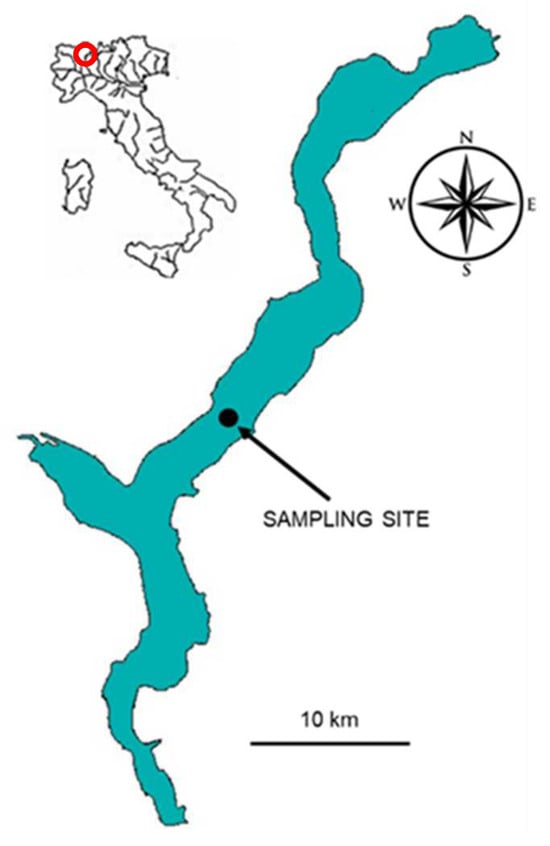
Figure 1.
Map of Lake Maggiore showing its location in the Italian peninsula (red circle) and the sampling site (black dot).
Stable Isotope Analyses (SIAs) of carbon (13C) and nitrogen (15N) were performed at the taxon level (i.e., Daphnia, Eubosmina, Diaphanosoma, Bythotrephes, Leptodora, cyclopoids and diaptomids). The organisms were sorted under a dissecting microscope in order to reach the minimum dry weight (DW) of 2 mg per sample (approximately 70–700 individuals, depending on their biomass). Samples were oven-dried for 24 h at 60 °C before being homogenized and transferred into tin capsules of 5 × 9 mm in size. Carbon and nitrogen isotopic compositions were determined by Ján Veizer Stable Isotope Laboratory (Ottawa University, Ontario, Canada) following methods already described in Caroni et al. [10] (for major details, please visit the laboratory website: https://www.uottawa.ca/research-innovation/isotope, accessed on 4 March 2025).
We assessed the normal distribution of the data (Shapiro–Wilk test [24]), Linear Regression, and Non-parametric Regression using the software SigmaPlot 11.0. The Quantreg R package was used for the Quantile Regression analyses, while the Mann–Kendal test was run with the software Matlab R2024b update 4 (24.2.0.2833386).
3. Results
Mean annual water temperature in the upper 10 m depth increased from 12.44 °C in 2013 to 15.00 °C in 2023; a positive trend of 0.23 °C·year−1 (Figure 2a) was significant at the α = 0.05 level according to the Mann–Kendall test (p-value = 0.043; [25,26]). The increase was particularly significant for February (0.08 °C, year−1; p-value = 0.02, α = 0.05). These results are consistent with those found by Fenocchi et al. [27] and Dresti et al. [28] (Figure 2a). The summer temperatures reached values of 24–25 °C in five out of the eleven years of the period. The minimum year temperature also increased from a value of 6.82 °C in 2013 to a maximum of 7.74 °C in 2023, with an overall increase of 0.92 °C in the eleven years of the period. With increasing temperatures, the duration of the thermal stratification also increased: during the initial years, thermal stratification lasted around 120 days, while being around 150 days in the most recent period (Figure 2b). The increasing annual trend was statistically significant (Non-parametric Regression, R = 0.850, N = 11; F = 23.374; p = 0.001). A yearly increase of 4.6 days led to an overall increase of ca. 1.5 months over the 11-year period analyzed.
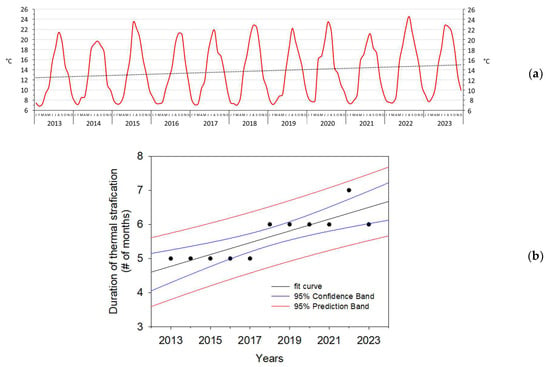
Figure 2.
(a) Changes in the monthly mean water temperature of the layer 0–10 m throughout the study period (black line referring to annual trend) and (b) thermal stratification regime in Lake Maggiore over the period 2013–2023.
The mean annual population density of Diaphanosoma increased during the decadal period, reaching, in 2023, the highest value of 10 ind L−1, 2.7 times higher than the average of the previous period (3.7 ind L−1; Figure 3).
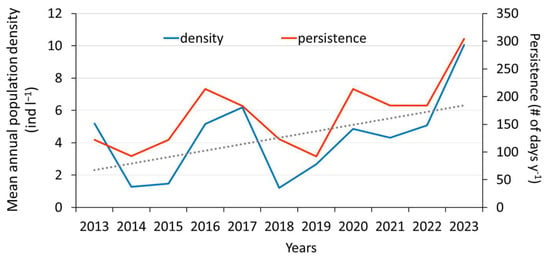
Figure 3.
Mean annual population density and yearly persistence in the water column of Diaphanosoma brachyurum in Lake Maggiore during the decadal period investigated. The gray dotted line shows the trend of the mean annual density of the population.
In addition to increasing population densities, Diaphanosoma became a persistent and stable component of the zooplankton community, with a three-fold increase in the number of days during which it was detected in the samples at a considerable level of abundance. While in the initial years of the period the presence of Diaphanosoma was restricted to 3.5 months (i.e., from early August to late October–early November), it became increasingly more persistent, with a presence of up to 5 months during the 2020s. Notable increases in population densities were, in fact, recorded from late June to early December, therefore highlighting a persistence in the lake for at least 200 calendar days.
The mean annual population density and persistence in the water column were strongly correlated (Linear Regression, N = 11, R = 0.875, F = 29.532, p < 0.001).
The quantile regression analysis reveals a positive relationship between water temperature and Diaphanosoma population density, providing information about the distribution of densities at different temperature ranges through quantile lines. The plot in Figure 4 suggests a general increase in Diaphanosoma densities with rising temperatures, as shown by the upward trend of the quantile lines.
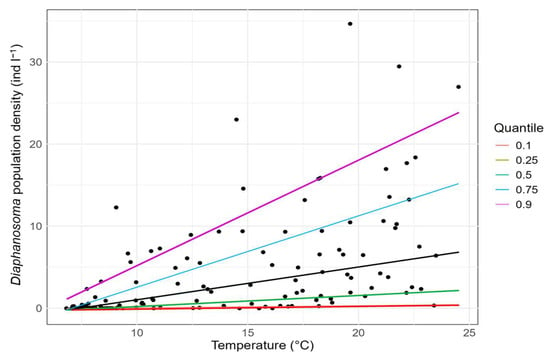
Figure 4.
Plot of quantile regression of Diaphanosoma population density (measured in ind L−1) against water temperature (°C). Quantile Lines are colored to represent different quantiles, red = 0.1; green = 0.25; black = 0.5; blue = 0.75; purple = 0.9, of the Diaphanosoma population density distribution across the range of temperatures.
4. Discussion
Many studies have demonstrated a strong relationship between global warming and lake thermal structure, including the onset and duration of thermal stratification, thermocline depth, and mean epilimnetic temperatures [29,30], in turn directly affecting plankton dynamics [31,32,33]. Our data highlighted not only a warming of the surficial waters (layer 0–10 depth) of Lake Maggiore but also an increased duration of the thermal stratification period. Warming likely influenced the population density of the thermophilic Diaphanosoma brachyurum directly by increasing its growth rate and indirectly by promoting the growth of its algal food sources (i.e., small-sized algae [34]). We observed that the increase in Diaphanosoma density and its persistence in the water column were related to the increase in the thermal stratification period in Lake Maggiore. Because Diaphanosoma is a thermophilic species, it has a physiological advantage in warmer and stratified water conditions [23,35] and is also likely to be favored by the observed decreased phytoplankton cell size in the lake [36,37,38]. This, in turn, might lead to changes in the pelagic food web, and it is reasonable to hypothesize that higher values of Diaphanosoma abundance and a longer duration of its presence might affect the competition with other filter feeders, such as Daphnia, and with predators (e.g., Leptodora and zooplanktivorous fish). Previous studies have demonstrated the existence of competition between Daphnia and Diaphanosoma [10]. Vicariance might be, however, a more appropriate definition of the ecological role of these two taxa: competition between them might be smoothed by the preference of different spatial niches, with Diaphanosoma occupying more surficial waters than Daphnia [39,40]. In addition, Daphnia and Diaphanosoma are characterized by different mesh sizes of the filtering apparatus, meaning that they exploit different food sources. The Daphnia inhabiting Lake Maggiore belongs to longispina-galeata gr., which is characterized by a mesh size of the filtering apparatus ranging between 0.17 and 1 µm; Diaphanosoma’s filtering comb distance is 0.16–0.24 µm [34,41]. Given its ability to exploit algae of a wider spectrum of sizes, however, Daphnia’s advantage over Diaphanosoma is likely counterbalanced by the higher predation pressure of zooplanktivorous fish [42,43,44]. This is also confirmed by previous studies regarding the carbon and nitrogen isotopic fingerprints of Lake Maggiore crustacean zooplankton (e.g., [10]). Figure 5 shows an example of the trophic structure of zooplankton organisms in Lake Maggiore. Organisms with a difference of ± 1.8‰ in carbon isotopic signature (δ13C) are considered to exploit the same food sources [10,45]. The graph (Figure 5) shows an overlap of food preferences between Daphnia, Diaphanosoma, and Eubosmina. The slightly less negative value of δ13C‰ of Diaphanosoma points out the preference for more surficial waters than the other two filter feeders [46]. The nitrogen isotopic signature suggests the ability of Diaphanosoma to also exploit cyanobacteria [47,48], which are generally characterized by a lower enrichment in δ15N‰ [49].
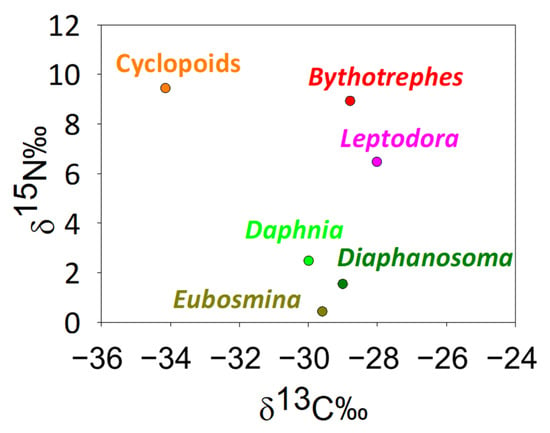
Figure 5.
Trophochemical graph showing carbon and nitrogen isotopic signatures of the main zooplankton taxa in Lake Maggiore in summer.
Diaphanosoma brachyurum is a part of the original pelagic zooplankton community of Lake Maggiore [9]. Its presence was already detected in early samples, dating back to the second half of the nineteenth century. It appeared very rarely in spring, having its main population growth phase in late summer–autumn, after the major development of Daphnia in June [50]. This feature of the seasonal dynamics of the zooplankton in Lake Maggiore was also common to other European deep lakes, as summarized by the well-known PEG model ([3]; https://www.cipais.org/web/lago-maggiore/rapporti; accessed on 10 February 2024). Diaphanosoma was, however, able to reach non-negligible values during a few years, especially during the month of August. Such was the case in the year 1993 when it was found to reach, on 12 August, a peak in population density of 13 ind L−1 [18]. However, the peak in population density detected in 1993 was exceptional, while the data of the eleven-year period analyzed suggest a gradual increase in both the density and persistence of this species in Lake Maggiore.
During the population density peak, an increase in Secchi depth water transparency from 5 m to 10 m unequivocally defined a summer clear-water phase [51] as a result of a decrease in algal density attributed to Diaphanosoma. By applying a theoretical filtering rate of Diaphanosoma of 2.48 mL ind−1 d−1, a clearance rate of 675,000 cells d−1 resulted in a rate that was very close to the rate of numerical decrease in the blue–greens during the clear-water period (727,000 cells d−1). Morabito et al. [18] interpreted the occurrence of the late-summer clear-water phase as evidence of the ecological vicariance of Diaphanosoma towards Daphnia. As already stated, such vicariance was confirmed by the outcome of the carbon and nitrogen stable isotopic analysis performed in Lake Maggiore (Figure 5).
Diaphanosoma has a lower mean body size than Daphnia; thus, its increase in population densities can be regarded as an indication of a general decrease in zooplankton body size and of the increasing importance of microzooplankton [38,52]. Such a transition towards small-sized taxa is confirmed by experimental work on the effect of warming in lakes on zooplankton and phytoplankton communities [53]. Our results are consistent with other field studies indicating that global warming leads to elevated metabolic rates and energy costs, favoring the development of smaller organisms [54,55]. Meanwhile, it is an indication of a trend towards a less stable environment in which temporary decoupling between predators/preys, grazers/phytoplankton-ultra-plankton, may result in algal blooms, as is increasingly observed in different seasons [39].
Author Contributions
Conceptualization, methodology, investigation, writing—original draft preparation and funding acquisition R.P., M.M. and R.P., formal analysis R.C., C.D. and R.P.; writing—review and editing, all authors. All authors have read and agreed to the published version of the manuscript.
Funding
This research was funded by CIPAIS (Commissione Internazionale per la Protezione delle Acque Italo-Svizzere).
Data Availability Statement
Data are available on request to CIPAIS (Commissione Internazionale per la Protezione delle Acque Italo-Svizzere; https://cipais.org, accessed on 4 March 2025).
Conflicts of Interest
The authors declare no conflicts of interest.
Appendix A
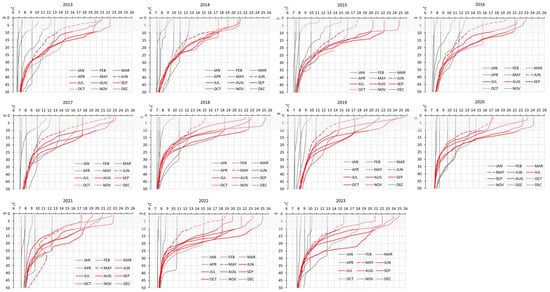
Figure A1.
Temperature vertical profiles recorded monthly during the period 2013–2023. Red lines show the period of thermal stratification of the water column (dotted lines refer to the onset, while pointed lines refer to the end of the stratification).
References
- Winder, M.; Schindler, D.E. Climatic effects on the phenology of lake processes. Glob. Change Biol. 2004, 10, 1844–1856. [Google Scholar] [CrossRef]
- Sommer, U.; Adrian, R.; De Senerpont Domis, L.; Elser, J.J.; Gaedke, U.; Ibelings, B.; Jeppesen, E.; Lürling, M.; Molinero, J.C.; Mooij, W.M.; et al. Beyond the Plankton Ecology Group (PEG) model: Mechanisms driving plankton succession. Annu. Rev. Ecol. Evolut. Syst. 2012, 43, 429–448. [Google Scholar] [CrossRef]
- Sommer, U.; Gliwicz, Z.M.; Lampert, W.; Duncan, A. The PEG-model of seasonal succession of planktonic events in fresh waters. Arch. Hydrobiol. 1986, 106, 433–471. [Google Scholar] [CrossRef]
- Walther, G.R.; Post, E.; Convey, P.; Menzel, A.; Parmesan, C.; Beebee, T.J.; Fromentin, J.-M.; Hoegh-Guldberg, O.; Bairlein, F. Ecological responses to recent climate change. Nature 2002, 416, 389–395. [Google Scholar] [CrossRef]
- Peeters, F.; Straile, D.; Lorke, A.; Livingstone, D.M. Earlier onset of the spring phytoplankton bloom in lakes of the temperate zone in a warmer climate. Glob. Change Biol. 2007, 13, 1898–1909. [Google Scholar] [CrossRef]
- Thomas, D.W.; Blondel, J.; Perret, P.; Lambrechts, M.M.; Speakman, J.R. Energetic and fitness costs of mismatching resource supply and demand in seasonally breeding birds. Science 2001, 291, 2598–2600. [Google Scholar] [CrossRef]
- Post, E.; Forchhammer, M.C.; Stenseth, N.C.; Callaghan, T.V. The timing of life–history events in a changing climate. Proc. R. Soc. Biol. Sci. Ser. B 2001, 268, 15–23. [Google Scholar] [CrossRef]
- Visser, M.E.; Holleman, L.J. Warmer springs disrupt the synchrony of oak and winter moth phenology. Proc. R. Soc. Biol. Sci. Ser. B 2001, 268, 289–294. [Google Scholar] [CrossRef]
- Manca, M.; Torretta, B.; Comoli, P.; Amsinck, S.L.; Jeppesen, E. Major changes in trophic dynamics in large, deep sub-alpine Lake Maggiore from 1940s to 2002: A high resolution comparative palaeo-neolimnological study. Freshw. Biol. 2007, 52, 2256–2269. [Google Scholar] [CrossRef]
- Caroni, R.; Piscia, R.; Free, G.; Manca, M. Interpreting Seasonal Patterns and Long-Term Changes of Zooplankton in a Deep Subalpine Lake Using Stable Isotope Analysis. Water 2023, 15, 3143. [Google Scholar] [CrossRef]
- Han, B.P.; Yin, J.; Lin, X.; Dumont, H.J. Why is Diaphanosoma (Crustacea: Ctenopoda) so common in the tropics? Influence of temperature and food on the population parameters of Diaphanosoma dubium, and a hypothesis on the nature of tropical cladocerans. Hydrobiologia 2011, 668, 109–115. [Google Scholar] [CrossRef]
- Dumont, H.J.; Han, B.P.; Guo, F.F.; Chen, H.; Cheng, D.; Liu, P.; Xu, L.; Sanoamuang, L.-O.; Rietzler, A.C.; Xu, S.; et al. Toward a phylogeny and biogeography of Diaphanosoma (Crustacea: Cladocera). Aquat. Ecol. 2021, 55, 1207–1222. [Google Scholar] [CrossRef]
- Dumont, H.J. On the diversity of the Cladocera in the tropics. Hydrobiologia 1994, 272, 27–38. [Google Scholar] [CrossRef]
- Hanazato, T.; Yasuno, M. Effect of temperature in the laboratory studies on growth, egg development and first parturition of five species of Cladocera. Jpn. J. Limnol. 1985, 46, 185–191. [Google Scholar] [CrossRef]
- Verbitskii, V.B.; Verbitskaya, T.I.; Malysheva, O.A. Population dynamics of Daphnia longispina (OF Müller, 1785) and Diaphanosoma brachyurum (Lievin, 1848) (Crustacea, Cladocera) under stable and graded temperature regimes. Biol. Bull. 2009, 36, 66–73. [Google Scholar] [CrossRef]
- CNR IRSA. Sede di Verbania. In Ricerche Sull’evoluzione Del Lago Maggiore. Aspetti Limnologici. Programma Triennale 2022–2024; Campagna 2023; Commissione Internazionale per la Protezione delle Acque Italo-Svizzere, Ed.; CNR IRSA: Rome, Italy, 2024; 112p. [Google Scholar]
- Choi, J.Y.; Jeong, K.S.; La, G.H.; Joo, G.J. Spatio-temporal distribution of Diaphanosoma brachyurum (Cladocera: Sididae) in freshwater reservoir ecosystems: Importance of maximum water depth and macrophyte beds for avoidance of fish predation. J. Limnol. 2015, 74, 403–413. [Google Scholar] [CrossRef][Green Version]
- Morabito, G.; Manca, M.; Ruggiu, D. Seasonal dynamics of planktonic communities in Lago Maggiore and clear-water phase during 1993. In Proceedings of the Atti XII Congresso AIOL, Isola di Vulcano, Italy, 18–21 September 1996; pp. 265–274. [Google Scholar]
- Doulka, E.; Kehayias, G. Seasonal vertical distribution and diel migration of zooplankton in a temperate stratified lake. Biologia 2011, 66, 308–319. [Google Scholar] [CrossRef]
- Tanentzap, A.J.; Morabito, G.; Volta, P.; Rogora, M.; Yan, N.D.; Manca, M. Climate warming restructures an aquatic food web over 28 years. Glob. Change Biol. 2020, 26, 6852–6866. [Google Scholar] [CrossRef]
- De Bernardi, R. Methods for the estimation of zooplankton abundance. In A Manual on Methods for the Assessment of Secondary Productivity in Fresh Waters; IBP Handbook; Wiley: Chichester, UK, 1984; Volume 17, pp. 59–86. [Google Scholar]
- Zhdanova, S.M. Diaphanosoma mongolianum Ueno, 1938 (Cladocera: Sididae) in Lakes of Yaroslavl Oblast (Russia). Inland Water Biol. 2018, 11, 145–152. [Google Scholar] [CrossRef]
- Vijverberg, J.; Koelewijn, H.P. Size dependent mortality and production of Diaphanosoma brachyurum (Lieven) in an eutrophic lake. Verh. Int. Ver. Theor. Angew. Limnol. 1991, 24, 2768–2771. [Google Scholar]
- Shapiro, S.S.; Wilk, M.B. An analysis of variance test for normality (complete samples). Biometrika 1965, 52, 591–611. [Google Scholar] [CrossRef]
- Mann, H.B. Nonparametric tests against trend. Econometrica 1945, 13, 245–259. [Google Scholar] [CrossRef]
- Kendall, M.G. Rank Correlation Methods, 4th ed.; Charles Griffin: London, UK, 1975. [Google Scholar]
- Fenocchi, A.; Rogora, M.; Sibilla, S.; Ciampittiello, M.; Dresti, C. Forecasting the evolution in the mixing regime of a deep subalpine lake under climate change scenarios through numerical modelling (Lake Maggiore, Northern Italy/Southern Switzerland). Clim. Dyn. 2018, 51, 3521–3536. [Google Scholar] [CrossRef]
- Dresti, C.; Rogora, M.; Fenocchi, A. Hypolimnetic oxygen depletion in a deep oligomictic lake under climate change. Aquat. Sci. 2023, 85, 4. [Google Scholar] [CrossRef]
- Schindler, D.W.; Beaty, K.G.; Fee, E.J.; Cruikshank, D.R.; DeBruyn, E.R.; Findlay, D.L.; Linsey, G.A.; Shearer, J.A.; Stainton, M.P.; Turner, M.A. Effects of climatic warming on lakes of the central boreal forest. Science 1990, 250, 967–970. [Google Scholar] [CrossRef]
- Magnuson, J.J.; Webster, K.E.; Assel, R.A.; Bowser, C.J.; Dillon, P.J.; Eaton, J.G.; Evans, H.E.; Fee, E.J.; Hall, R.I.; Mortsch, L.R.; et al. Potential effects of climate changes on aquatic systems: Laurentian Great Lakes and Precambrian Shield Region. Hydrol. Process. 1997, 11, 825–871. [Google Scholar] [CrossRef]
- Straile, D. Meteorological forcing of plankton dynamics in a large and deep continental European lake. Oecologia 2000, 122, 44–50. [Google Scholar] [CrossRef]
- Gerten, D.; Adrian, R. Species-specific changes in the phenology and peak abundance of freshwater copepods in response to warm summers. Freshw. Biol. 2002, 47, 2163–2173. [Google Scholar] [CrossRef]
- Arhonditsis, G.B.; Brett, M.T.; Degasperi, C.L.; Schindler, D.E. Meteorological forcing of thermal dynamics in Lake Washington (USA). Limnol. Oceanogr. 2004, 49, 256–270. [Google Scholar] [CrossRef]
- Geller, W.; Müller, H. The filtration apparatus of Cladocera: Filter mesh-sizes and their implications on food selectivity. Oecologia 1981, 49, 316–321. [Google Scholar] [CrossRef]
- Herzig, A. Temperature and life cycle strategies of Diaphanosoma brachyurum: An experimental study on development, growth, and survival. Arch. Hydrobiol. 1984, 101, 143–178. [Google Scholar]
- Ruggiu, D.; Morabito, G.; Panzani, P.; Pugnetti, A. Trends and relations among basic phytoplankton characteristics in the course of the long-term oligotrophication of Lake Maggiore (Italy). In Phytoplankton and Trophic Gradients, Proceedings of the 10th Workshop of the International Association of Phytoplankton Taxonomy & Ecology (IAP), held in Granada, Spain, 21–29 June 1996; Springer: Dordrecht, The Netherlands, 1988; pp. 243–247. [Google Scholar]
- Kamenir, Y.; Morabito, G. Lago Maggiore oligotrophication as seen from the long-term evolution of its phytoplankton taxonomic size structure. J. Limnol. 2009, 68, 146–161. [Google Scholar] [CrossRef]
- Caroni, R.; Piscia, R.; Manca, M. Indicators of Climate-Driven Change in Long-Term Zooplankton Composition: Insights from Lake Maggiore (Italy). Water 2025, 17, 511. [Google Scholar] [CrossRef]
- Matveev, V.F. Effect of competition on the demography of planktonic cladocerans—Daphnia and Diaphanosoma. Oecologia 1987, 74, 468–477. [Google Scholar] [CrossRef]
- Adamczuk, M. Predation follows competition in depth selection behaviour of Cladocera in a deep lake (E Poland). Biol. Lett. 2009, 46, 29–36. [Google Scholar] [CrossRef]
- Nagata, T. Filter mesh-sizes of Daphnia longispina and its filtering rates on natural bacteria. Mem. Fac. Sci. Kyoto Univ. Ser. Biol 1985, 10, 109–114. [Google Scholar]
- Gliwicz, Z.M. Studies on the feeding of pelagic zooplankton in lakes with varying trophy. Ekol. Pol. Ser. A. 1969, 12, 663–708. [Google Scholar]
- De Bernardi, R.; Giussani, G.; Manca, M. Cladocera: Predators and prey. In Cladocera: Proceedings of the Cladocera Symposium, Budapest 1985; Springer: Dordrecht, The Netherlands, 1987; pp. 225–243. [Google Scholar]
- Pothoven, S.A. The influence of ontogeny and prey abundance on feeding ecology of age-0 Lake Whitefish (Coregonus clupeaformis) in southeastern Lake Michigan. Ecol. Freshw. Fish 2020, 29, 103–111. [Google Scholar] [CrossRef]
- DeNiro, M.J.; Epstein, S. Influence of diet on the distribution of nitrogen isotopes in animals. Geochim. Cosmochim. Acta 1981, 45, 341–351. [Google Scholar] [CrossRef]
- Jones, R.I.; Grey, J.; Sleep, D.; Quarmby, C. An assessment, using stable isotopes, of the importance of allochthonous organic carbon sources to the pelagic food web in Loch Ness. Proc. R. Soc. Lond. B Biol. Sci. 1998, 265, 105–110. [Google Scholar] [CrossRef]
- Fulton, R.S.; Paerl, H.W. Effects of the blue-green alga Microcystis aeruginosa on zooplankton competitive relations. Oecologia 1988, 76, 383–389. [Google Scholar] [CrossRef]
- Nandini, S.; Sarma, S.S.S. Experimental studies on zooplankton-toxic cyanobacteria interactions: A review. Toxics 2023, 11, 176. [Google Scholar] [CrossRef] [PubMed]
- Montoya, J.P.; Carpenter, E.J.; Capone, D.G. Nitrogen fixation and nitrogen isotope abundances in zooplankton of the oligotrophic North Atlantic. Limnol. Oceanogr. 2002, 47, 1617–1628. [Google Scholar] [CrossRef]
- De Bernardi, R.; Canali, S. Population dynamics of pelagic cladocerans in Lago Maggiore. Mem. Ist. ital. Idrobiol. 1975, 32, 365–392. [Google Scholar]
- Lampert, W.; Fleckner, W.; Rai, H.; Taylor, B.E. Phytoplankton control by grazing zooplankton: A study on the spring clear-water phase 1. Limnol. Oceanogr. 1986, 31, 478–490. [Google Scholar] [CrossRef]
- Daufresne, M.; Lengfellner, K.; Sommer, U. Global warming benefits the small in aquatic ecosystems. Proc. NatL. Acad. Sci. USA 2009, 106, 12788–12793. [Google Scholar] [CrossRef]
- Brucet, S.; Boix, D.; Quintana, X.D.; Jensen, E.; Nathansen, L.W.; Trochine, C.; Meerhoff, M.; Gascó, S.; Jeppesen, E. Factors influencing zooplankton size structure at contrasting temperatures in coastal shallow lakes: Implications for effects of climate change. Limnol. Oceanogr. 2010, 55, 1697–1711. [Google Scholar] [CrossRef]
- Moore, M.; Folt, C. Zooplankton body size and community structure: Effects of thermal and toxicant stress. Trends Ecol. Evol. 1993, 8, 178–183. [Google Scholar] [CrossRef]
- Zohary, T.; Flaim, G.; Sommer, U. Temperature and the size of freshwater phytoplankton. Hydrobiologia 2021, 848, 143–155. [Google Scholar] [CrossRef]
Disclaimer/Publisher’s Note: The statements, opinions and data contained in all publications are solely those of the individual author(s) and contributor(s) and not of MDPI and/or the editor(s). MDPI and/or the editor(s) disclaim responsibility for any injury to people or property resulting from any ideas, methods, instructions or products referred to in the content. |
© 2025 by the authors. Licensee MDPI, Basel, Switzerland. This article is an open access article distributed under the terms and conditions of the Creative Commons Attribution (CC BY) license (https://creativecommons.org/licenses/by/4.0/).